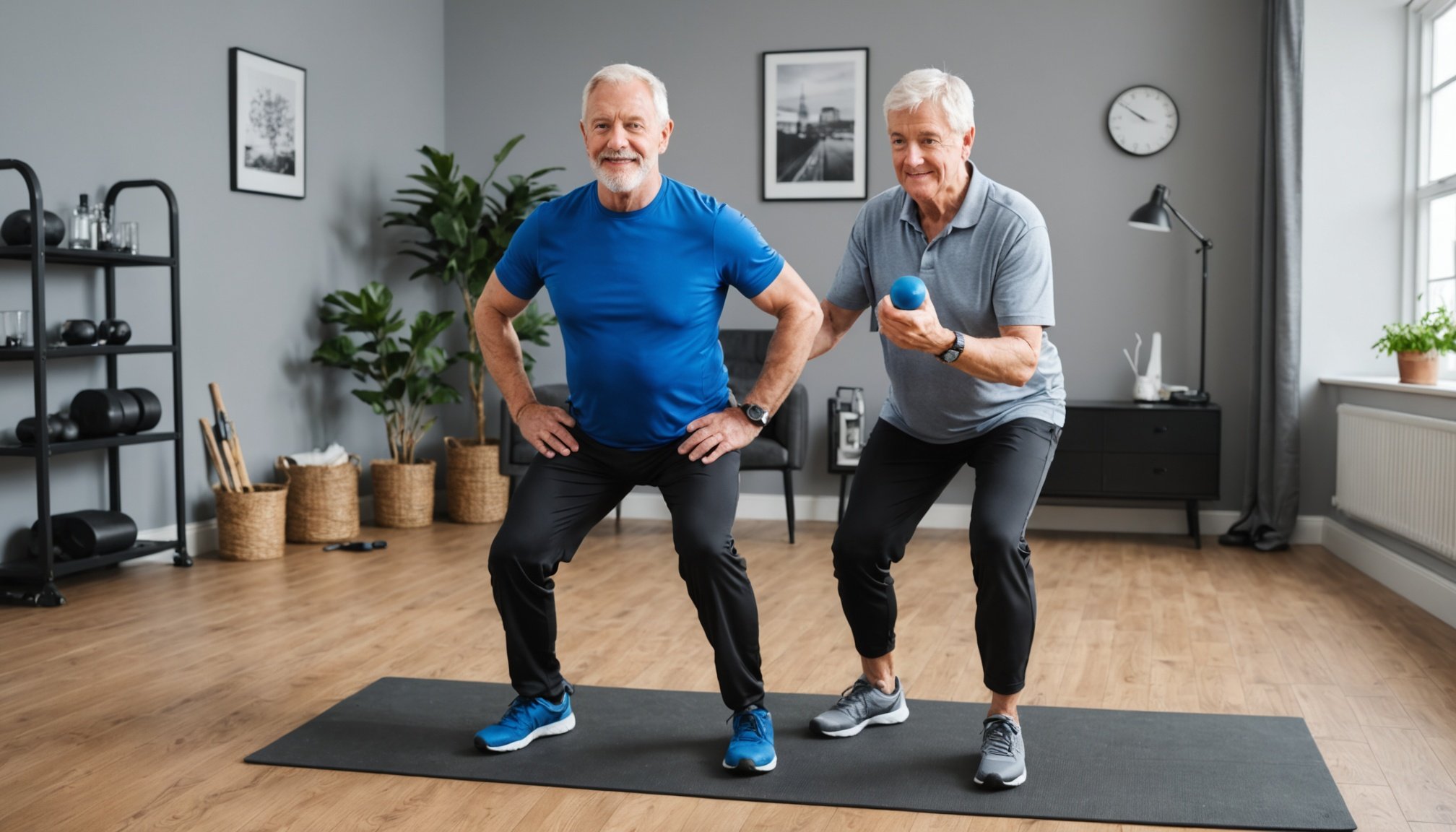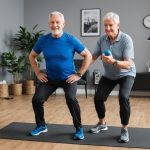Understanding Strength Training for Older Adults
For those navigating fitness over 50, strength training emerges as a crucial form of exercise. Not only does it aid in maintaining mobility, but it also significantly boosts overall health. Engaging in regular strength training helps older adults preserve independence by enhancing muscle mass and bone density, which are vital for reducing the risk of falls and injuries.
Delving deeper, the health improvement from such activities extends beyond the physical. Strength training is associated with mental health benefits, offering improved mood and cognitive function. It can also decrease the chances of developing chronic conditions such as arthritis, diabetes, and cardiovascular diseases, contributing to a healthy and active lifestyle.
Also to see : Top Tips for UK Pet Owners: Keeping Your Cat Healthy and at the Perfect Weight
Despite these benefits, several myths persist around aging and physical activity. A common misconception is that exercise intensity should drastically decrease as we age. In reality, while modifications are necessary, older adults can engage in strength training safely and effectively, resulting in pronounced strength training benefits.
Myths that suggest old age leads to decline in capabilities are misleading. Regular physical activity challenges these myths, showing that maintaining an active lifestyle can enhance not just physical fitness but also mental acuity, independence, and quality of life for older adults.
In parallel : Mastering Stress Relief: A UK Resident”s Guide to Mindful Breathing Techniques
Beginner-Friendly Strength Training Exercises
Starting a strength training routine at home is both accessible and efficient. It requires only a small space and minimal equipment for effective progress. Bodyweight exercises are particularly beneficial for beginners to build strength without needing complex machines.
Upper Body Exercises
Strengthening the upper body can enhance daily functionality and improve posture. Push-ups, whether traditional or wall variations, serve as versatile options. They engage the chest, shoulders, and triceps effectively. To further develop arm strength, investing in a set of resistance bands enables countless exercises, such as bicep curls and tricep extensions. Furthermore, seated dumbbell exercises are ideal for those requiring extra stability or comfort. With a pair of dumbbells, exercises like shoulder presses and lateral raises can be performed conveniently at home.
Lower Body Exercises
Engaging the lower body is crucial for balance and mobility. Squats, with their variation like chair squats, are simple yet highly effective. They target multiple muscle groups including thighs and glutes. Consider adding standing leg lifts or side leg raises to the routine to enhance hip stability and strength. By including calf raises, overall balance and stability can be improved significantly.
Core Strengthening Exercises
Core exercises are valuable for maintaining overall body stability. Seated torso twists are excellent for core activation without straining the back. For a gentler lower back and hip enhancement, glute bridges are advisable. Modified planks cater to varying fitness levels, ensuring that everyone can participate regardless of experience.
Safety Tips for Effective Workouts
Engaging in regular exercise can greatly benefit your physical health and well-being, but it is vital to pay attention to workout safety to avoid injuries and setbacks.
Before embarking on any new fitness program, it is essential to consult with healthcare professionals. They can provide personalised exercise guidelines that take into account your current health status and any pre-existing conditions, ensuring a safe and effective workout routine tailored specifically for you.
Warming-up is crucial for injury prevention. It prepares your body for the physical activity ahead by increasing blood flow and loosening muscles. A typical warm-up might include light cardio followed by dynamic stretching.
Equally important is the cool-down phase. It helps bring your heart rate back to normal gradually and reduces muscle soreness. Gentle stretching is recommended to maintain flexibility and prevent stiffness.
Hydration plays a key role in maintaining workout safety. Dehydration can lead to cramping and fatigue. Make sure to drink water before, during, and after exercises.
Lastly, always listen to your body during workouts. If you experience any pain or discomfort, stop immediately and assess the situation. This mindful approach is integral to effective injury prevention and sustaining a healthy exercise regimen.
Modifications for Varying Fitness Levels
The world of exercise is vast, with workouts available that cater to every individual’s needs and abilities. Understanding how to tailor exercise modifications can make fitness more inclusive.
Adjusting Exercises for Beginners
Novices can benefit from a gradual approach to ensure workouts remain accessible. Beginners should focus on slower progression when building strength. This involves allowing the body to adapt to new routines. Tools like chairs or walls can be used as support during exercises, providing stability. It’s essential to incorporate rest days, giving the body time to recover and prevent injury.
Advanced Options for More Experienced Individuals
For those with more experience, enhancing the challenge can be achieved through advanced exercise modifications. Adding resistance bands or light weights offers increased difficulty. Adjusting workouts to include higher repetitions or additional sets can further boost intensity. These individuals often combine strength training with balance and flexibility workouts.
By accommodating different fitness levels, everyone can engage in physical activity that suits their capabilities, making exercise a more individualized and satisfying experience.
Community Support and Motivation Strategies
Engaging with a fitness community can significantly boost your motivation. Whether joining a local gym or an online forum, the power of shared experiences should not be underestimated. These groups provide a platform for individuals to share tips, successes, and setbacks, fostering a sense of camaraderie.
Finding workout groups that align with your fitness goals is crucial. These groups often offer structured programs tailored to various fitness levels, ensuring you have the right support. They also help maintain motivation through regular interactions and shared milestones. By observing peers achieving their goals, you gain fresh enthusiasm and drive.
One effective way of cultivating motivation is by sharing success stories. When you articulate your journey and the obstacles you’ve overcome, it serves as a powerful motivator for others in similar situations. Your experiences can inspire someone struggling, showing them that their aspirations are achievable.
Beyond participating in fitness groups, setting realistic goals and celebrating small achievements is a practical strategy to sustain motivation. Each success, however minor, represents progress. Acknowledging these wins encourages perseverance, making the broader objective seem more attainable. Therefore, embracing community support fosters both motivation and a more focused approach to fitness.
Nutritional Advice to Complement Workouts
Maintaining a balanced nutrition for strength training is essential for maximising workout results. Crucially, protein intake plays a significant role in muscle repair and growth. Without adequate protein, muscles cannot recover or strengthen effectively after intense training sessions. For those aiming to build muscle, incorporating protein-rich foods such as lean meats, eggs, and legumes into their diet is recommended.
When it comes to dietary advice, older adults might require specific attention to supplements and vitamins. As the body ages, its nutritional needs can change, leading to deficiencies which can hinder workout performance and recovery. Supplements like vitamin D, calcium, and omega-3 fatty acids can be beneficial in supporting bone health and reducing inflammation, thus aiding in overall strength training efforts.
Furthermore, maintaining proper hydration is crucial. Water facilitates nutrient transport and helps regulate body temperature, both vital during exercise. Paired with balanced meals that include a variety of nutrients, hydration can greatly enhance overall health. Ensuring a diet rich in fruits, vegetables, whole grains, and healthy fats in alignment with strength training goals promotes sustained energy levels and aids in recovery, optimising the benefits of physical activity.
Additional Resources for Guidance
Understanding and implementing exercise routines can be enhanced through engaging educational materials. These resources cater to varying levels of fitness, making them suitable for everyone.
Video Demonstrations and Tutorials
For those seeking guidance, several reputable online platforms provide tailored exercise videos, specifically designed for older adults. These include:
- SilverSneakers: Offers a variety of virtual classes focusing on gentle movement and strength exercises.
- ElderGym: Provides accessible strength training videos emphasising safety and efficacy.
These platforms often feature professionals who understand the unique needs of older individuals, ensuring exercises are both safe and beneficial.
Books and Articles on Strength Training
When it comes to educational materials on strength training, some books delve into the science and practical applications. Renowned authors include:
- Dr. Wayne Wescott, known for his works on strength training for seniors.
- Joan Pagano, offering detailed insights through her publications.
These resources are backed by research studies highlighting the benefits of exercise for older adults, ensuring readers understand the foundational concepts.
Success Stories and Testimonials
Personal accounts and encouraging narratives can be powerful. Many individuals have overcome barriers to fitness, sharing their stories to inspire others. These testimonials create a sense of community, showing that age is not a barrier to achieving health goals.











